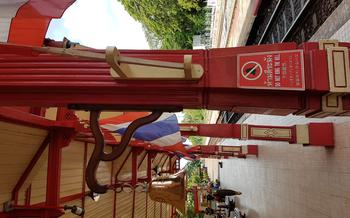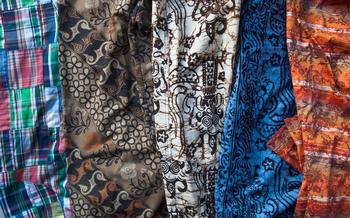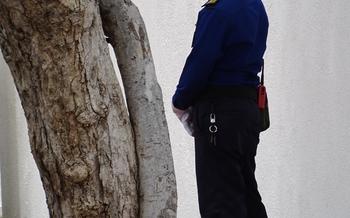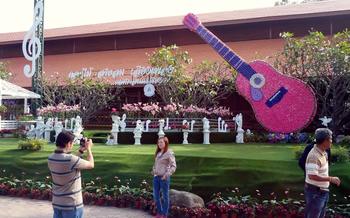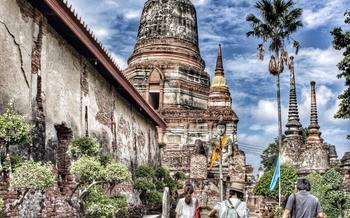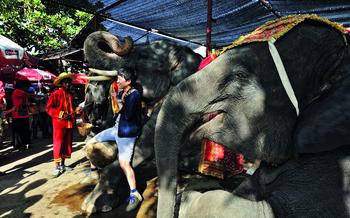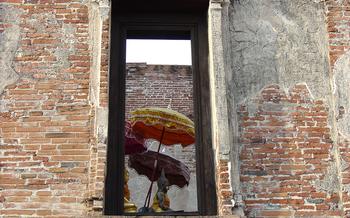
Santisuk Market
- Santisuk Market: A Cultural Haven in Songkhla
- Exploring the Market: A Sensory Journey
- Local Delights: A Culinary Journey Through Songkhla's Flavors
- Handicrafts and Souvenirs
- Cultural Performances
- Temples and Shrines
- Photography Opportunities
- History and Heritage
- Local Festivals: A Vibrant Celebration of Songkhla's Heritage
- Off-the-Beaten-Path Experiences
- Sustainability and Eco-Consciousness
- Health and Safety
- Accessibility
- Insider Tip: Unveiling Hidden Gems
Santisuk Market: A Cultural Haven in Songkhla
Nestled in the heart of Songkhla, Thailand, the Santisuk Market stands as a vibrant testament to the region's rich cultural heritage. Its origins can be traced back to the early 20th century when it served as a trading hub for local farmers and fishermen. Over the years, the market has evolved into a melting pot of cultures, attracting visitors from near and far who seek authentic experiences and unique treasures.
Located in the bustling city center, the Santisuk Market is easily accessible by foot, bicycle, or public transportation. Its strategic position along the main road makes it a convenient stop for both locals and tourists alike. Unlike other markets in Thailand, which often cater primarily to tourists, the Santisuk Market retains its strong local identity. It is a place where residents come to shop for daily necessities, socialize, and celebrate their shared traditions.
Exploring the Market: A Sensory Journey
To fully immerse yourself in the vibrant atmosphere of Santisuk Market, it's best to visit on weekends or public holidays when the market is bustling with activity. Arrive early in the morning to beat the heat and crowds, and you'll be rewarded with the freshest produce, the most vibrant colors, and the most enthusiastic vendors.
As you wander through the labyrinthine alleys of the market, you'll be greeted by an assault of sights, sounds, and smells that will awaken your senses. The air is filled with the sweet aroma of tropical fruits, the smoky fragrance of grilled meats, and the heady scent of jasmine garlands. The cacophony of voices, the clanging of pots and pans, and the cheerful banter of vendors create a lively symphony that envelops you as you explore.
Among the stalls, you'll find an array of local produce, from exotic fruits like mangosteen and rambutan to fresh seafood caught daily from the nearby Gulf of Thailand. There are also colorful displays of handmade crafts, from intricately woven textiles to delicate pottery and gleaming silver jewelry.
To truly experience the essence of the market, don't be afraid to venture off the beaten path and explore the smaller alleys. Here, you'll find hidden gems like specialty food stalls serving up mouthwatering local dishes, artisans demonstrating their traditional crafts, and friendly locals eager to share stories about their culture.
Remember to engage with the vendors and ask questions about their products. They'll be delighted to share their knowledge and help you find the perfect souvenirs or ingredients for your next culinary adventure.
Local Delights: A Culinary Journey Through Songkhla's Flavors
Indulge in the culinary delights that await you at the Santisuk Market, where the air is filled with tantalizing aromas and the vibrant stalls invite you to embark on a gastronomic adventure. Start your journey with the freshly caught seafood, grilled to perfection and served with a tangy sauce that awakens your taste buds. Sample the aromatic curries, simmering in coconut milk and brimming with an explosion of flavors that dance on your palate. Don't miss the sweet treats, a testament to Songkhla's rich culinary heritage. Bite into the chewy coconut pancakes, the crispy fried bananas, or the melt-in-your-mouth mango sticky rice, a symphony of textures and flavors that will leave you craving more.
The unique flavors of Songkhla's cuisine are a reflection of the region's diverse cultural influences. From the spicy curries that hint at the fiery flavors of neighboring Malaysia to the delicate sweetness of desserts that showcase the region's abundant tropical fruits, each dish tells a story of Songkhla's rich history and culinary traditions.
To fully immerse yourself in the local food scene, make your way to the market's food stalls, where friendly vendors will gladly guide you through their culinary creations. Ask about their favorite dishes, learn about the ingredients they use, and don't be afraid to try something new. Whether you're a seasoned foodie or simply looking for a taste of authentic Thai cuisine, the Santisuk Market is a culinary paradise waiting to be explored.
Handicrafts and Souvenirs
Santisuk Market is a treasure trove of distinctive handicrafts and souvenirs that reflect the rich cultural heritage of Songkhla. Visitors will be captivated by the intricate handwoven textiles, colorful pottery, and unique jewelry that are lovingly crafted by local artisans. Each item tells a story, preserving and celebrating the traditions of the region.
Handwoven Textiles: Stroll through the market and discover an array of handwoven textiles, from delicate silk scarves to vibrant cotton sarongs. These textiles are a testament to the skill and artistry of local weavers, who use traditional techniques passed down through generations.
Pottery: Songkhla is renowned for its exquisite pottery, crafted from the finest local clay. Browse the market stalls to find a variety of ceramic pieces, from decorative vases and bowls to whimsical figurines. Each item is a unique work of art, showcasing the creativity and craftsmanship of local potters.
Jewelry: Adorn yourself with beautiful jewelry handmade by local artisans. From delicate silver filigree to shimmering gemstones, the market offers a stunning selection of earrings, necklaces, and bracelets. These pieces are not only a fashion statement but also a symbol of the region's rich cultural heritage.
Cultural Significance: The handicrafts and souvenirs found at Santisuk Market are more than just beautiful objects; they are a tangible connection to the traditions and way of life of the local community. By purchasing these items, visitors not only support local artisans but also contribute to the preservation of cultural heritage.
Bargaining: Bargaining is a common practice at Santisuk Market, and it's a great way to connect with the friendly vendors and score a good deal. Remember to approach bargaining with respect and a sense of humor, and be prepared to walk away if the price is too high.
Supporting Local Artisans: When shopping at Santisuk Market, visitors have the opportunity to directly support local artisans and their families. By purchasing their handmade goods, you contribute to the preservation of traditional crafts and help sustain the local economy.
Cultural Performances
The Santisuk Market is not just a place for shopping and dining; it is also a hub for traditional Thai cultural performances. Visitors might encounter mesmerizing music performances featuring traditional instruments like the khene (bamboo mouth organ) or the khaen (bamboo xylophone). These melodies, often accompanied by rhythmic drumming, create a lively atmosphere that enchants the market-goers.
In addition to music, visitors can witness graceful Thai dance performances that showcase the country's rich cultural heritage. These dances, often performed by skilled troupes in colorful costumes, tell stories of love, mythology, and everyday life. The intricate movements and expressive gestures captivate the audience, providing a glimpse into the soul of Thai culture.
Puppet shows are another popular form of entertainment at the market. These traditional performances feature intricate hand-crafted puppets that bring age-old tales to life. The puppeteers skillfully manipulate the puppets, creating a magical world where mythical creatures and human characters interact in enchanting stories.
These cultural performances are not just entertainment; they are a way to preserve and celebrate local traditions. They connect visitors with the rich history and heritage of Songkhla and provide a deeper understanding of the Thai way of life. To catch these captivating performances, visitors should inquire at the market's information booth for show schedules and locations.
Temples and Shrines
Within the bustling maze of the Santisuk Market, there lies a serene sanctuary of spirituality, where the sacred and the profane intertwine harmoniously. Temples and shrines, adorned with intricate carvings and vibrant murals, stand as testaments to the deep-rooted faith and devotion of the local community. These sacred spaces offer a respite from the lively market atmosphere, inviting visitors to pause and reflect upon the rich cultural heritage of Songkhla.
One of the most prominent temples within the market is Wat Sadet, a beautifully preserved structure that dates back to the Ayutthaya period. Its elegant architecture, featuring a towering prang (spire) and meticulously crafted stupas, showcases the exquisite craftsmanship of ancient artisans. Devotees flock to Wat Sadet to pay homage to the revered Buddha images enshrined within its hallowed halls, seeking blessings and guidance in their daily lives.
Another notable shrine is the San Chao Mae Tubtim, dedicated to a revered female spirit known for her benevolence and protective powers. Locals and visitors alike seek her blessings for good fortune, health, and prosperity, leaving offerings of flowers, incense, and other tokens of devotion. The shrine is adorned with colorful decorations and exudes a palpable sense of spirituality, attracting a steady stream of devotees throughout the day.
These sacred spaces within the Santisuk Market serve as reminders of the deep-seated religious beliefs and practices that permeate Thai culture. Visitors are welcome to respectfully explore these temples and shrines, observing local customs and etiquette to ensure a harmonious and immersive experience.
Photography Opportunities
The Santisuk Market is a photographer's paradise, with its vibrant colors, unique architecture, and lively atmosphere. Every corner of the market offers a potential photo opportunity, from the colorful stalls to the smiling faces of the vendors and shoppers.
Tips for Capturing the Essence of the Market
-
Arrive early to capture the market as it comes alive. The morning light is particularly beautiful, casting a warm glow over the stalls and creating long shadows that add depth to your photos.
-
Take your time to explore the market and find unique angles and perspectives. Don't be afraid to get close to your subjects and capture the details that make the market so special.
-
Experiment with different shutter speeds to capture the movement and energy of the market. A slow shutter speed will blur the moving subjects, creating a sense of motion, while a fast shutter speed will freeze the action.
-
Don't forget to interact with the locals. Ask them if you can take their photo and engage in conversation. They will often be happy to share their stories and experiences, which can add another layer of interest to your photos.
History and Heritage
Songkhla's rich history is deeply intertwined with the Santisuk Market. The city has served as a crucial trading hub for centuries, attracting merchants from across the region. The market, with its diverse array of goods and vibrant atmosphere, played a pivotal role in facilitating this exchange.
Over the years, the market has witnessed countless transformations, adapting to changing times while retaining its unique identity. In the past, it was primarily a place for locals to trade agricultural products and handicrafts. However, with the influx of tourism, the market has expanded to include a wider variety of goods, including souvenirs and handmade crafts catering to visitors from around the world.
Despite these changes, the market has managed to preserve its authenticity. It remains a bustling center of commerce, where locals and tourists alike can come together to experience the true essence of Songkhla.
The market is also home to several historical landmarks, including temples and shrines that hold deep cultural and religious significance for the local community. These sacred spaces offer visitors a glimpse into Songkhla's rich spiritual heritage.
By exploring the Santisuk Market, visitors can gain a deeper understanding of Songkhla's fascinating history and heritage. The market is a living testament to the city's resilience and its ability to embrace change while honoring its traditions.
Local Festivals: A Vibrant Celebration of Songkhla's Heritage
Songkhla's annual kite festival, held during the windy season from January to February, is a spectacle not to be missed. The skies above the market and the city come alive with a kaleidoscope of colors as hundreds of kites of all shapes and sizes dance in the breeze. Locals and visitors alike participate in this joyous event, competing to see whose kite flies the highest or displays the most unique design. The festival is a celebration of creativity, craftsmanship, and the community's shared love for their city.
Another notable event is the Songkhla Vegetarian Festival, which takes place over nine days in October. During this time, the market transforms into a haven for vegetarians, with stalls offering a wide variety of meat-free dishes, from mock meats to fresh fruits and vegetables. The festival is a testament to the city's diverse culinary traditions and its commitment to promoting a healthy lifestyle.
To truly immerse yourself in the local culture, plan your visit to coincide with one of these vibrant festivals. You'll have the chance to witness firsthand the rich traditions and warm hospitality that make Songkhla so special.
Off-the-Beaten-Path Experiences
Apart from the main market area, adventurous travelers can venture into hidden corners to uncover unique experiences. Explore the sois, or small alleys, branching off from the main market streets to find hidden stalls selling traditional snacks and delicacies unknown to most tourists. Discover local artisans who have mastered traditional crafts passed down through generations, such as hand-woven textiles, intricate pottery, and delicate jewelry. These artisans often work in small workshops or homes within the market, offering a glimpse into their creative process. Engage in conversations with them to learn about their techniques and the stories behind their creations. Supporting these local artisans not only helps preserve traditional skills but also contributes to the sustainable development of the community.
Sustainability and Eco-Consciousness
The Santisuk Market is committed to promoting sustainability and reducing its environmental impact. Visitors will find eco-friendly practices throughout the market, such as the use of biodegradable packaging, recycling bins, and a ban on single-use plastics. By supporting the market, visitors can contribute to these initiatives and help to preserve the natural beauty of Songkhla.
Eco-Friendly Initiatives:
-
Reduced Plastic Waste: The market actively discourages the use of single-use plastic bags and utensils. Visitors are encouraged to bring their own reusable bags and containers or purchase eco-friendly alternatives from vendors.
-
Recycling and Composting: Recycling bins are conveniently placed throughout the market for visitors to dispose of their waste responsibly. Food scraps and organic waste are composted to create nutrient-rich soil for local gardens.
-
Sustainable Packaging: Many vendors use biodegradable materials for their packaging, such as banana leaves, bamboo containers, and recycled paper. This helps to reduce the amount of plastic waste generated by the market.
-
Water Conservation: The market has invested in water-saving technologies, such as low-flow faucets and rainwater harvesting systems. This helps to reduce the market's water consumption and conserve this precious resource.
-
Green Spaces: The market incorporates green spaces and plants throughout its premises to create a pleasant and sustainable environment. These green areas help to improve air quality, reduce heat island effects, and provide habitat for local wildlife.
By embracing these eco-conscious practices, the Santisuk Market sets an example for other markets in Thailand and around the world. Visitors can feel good about supporting a sustainable market that is committed to preserving the environment for future generations.
Health and Safety
Navigating the bustling Santisuk Market requires a certain level of awareness and caution to ensure a safe and enjoyable experience. While the market is generally safe, being mindful of your surroundings and taking necessary precautions is essential.
-
Personal Safety: Be vigilant against pickpocketing and scams, which can occur in crowded marketplaces. Keep your valuables secure and avoid carrying large sums of cash.
-
Sun Protection: Songkhla's tropical climate can be intense, so protect yourself from the sun by wearing a hat, sunglasses, and applying sunscreen regularly.
-
Hydration: Stay hydrated by carrying a water bottle or purchasing drinks from the many vendors in the market.
-
Medical Assistance: In case of any medical emergencies, there are several pharmacies and clinics located within walking distance of the market.
Remember, respecting local customs and etiquette is crucial. Dress modestly, avoid loud noises, and be mindful of religious practices when visiting temples or shrines. Following these guidelines will ensure a safe and respectful experience at the Santisuk Market.
Accessibility
The Santisuk Market is committed to ensuring that everyone, regardless of their abilities, can enjoy the vibrant atmosphere and unique offerings it has to offer. Visitors with disabilities or special needs will find that the market is well-equipped to accommodate them.
Ramps and elevators: The market features ramps and elevators at all entrances, making it easy for wheelchair users and individuals with mobility challenges to navigate the premises.
Accessible restrooms: Clean and well-maintained accessible restrooms are available throughout the market, providing a sense of comfort and convenience for visitors with disabilities.
Inclusive shopping experience: Market vendors are known for their friendly and helpful nature, always willing to assist shoppers with disabilities. They can provide guidance, carry heavy bags, or recommend products that cater to specific needs.
Tips for an inclusive visit:
- When visiting the market, inform the security personnel or market staff about any special needs or assistance required.
- Plan your visit during non-peak hours to avoid crowds and navigate the market more comfortably.
- Take breaks and rest when needed. Seating areas are available throughout the market for visitors to relax and recharge.
- Utilize the available resources, such as maps and signage, to find accessible routes and amenities within the market.
Insider Tip: Unveiling Hidden Gems
For those seeking an authentic culinary experience, venture off the beaten path to discover a hidden gem within the Santisuk Market. Tucked away in a narrow alley, you'll find a small eatery known for its mouthwatering local delicacies at incredibly affordable prices. From freshly caught seafood grilled to perfection to aromatic curries bursting with flavor, this hidden gem is a true culinary haven.
But that's not all. The Santisuk Market also holds a secret alleyway that leads to a hidden temple perched atop a hill. This serene sanctuary offers breathtaking panoramic views of the city and surrounding landscapes. As you climb the steps to the temple, you'll be greeted by intricate carvings and stunning murals depicting scenes from Thai mythology. Take a moment to soak in the tranquility and appreciate the exquisite craftsmanship that adorns this sacred space.
Finally, if you happen to visit the market on a Wednesday evening, be sure to catch the weekly cultural performance showcasing traditional Thai dance and music. This vibrant display of artistry and heritage takes place at the market's central stage and is a must-see for anyone seeking a truly immersive cultural experience.
